Science of a healthy lifestyle (quiz 2)
1/98
There's no tags or description
Looks like no tags are added yet.
Name | Mastery | Learn | Test | Matching | Spaced |
|---|
No study sessions yet.
99 Terms
Module 3 Part 1…
Macronutrients
nutrients that must be consumed in large amounts.
carbohydrates
protein
fats
Micronutrients
nutrients needed in small or trace amounts.
vitamin
minerals
water - MOST PEOPLE FORGET
Dietary components and concepts
Most Americans have an imbalance of nutrients and foods they are required to eat to support health and wellness.
ST (short term) - reduces and impairs body precesses
LT (long term) - type 2 diabetes mellitus - heart disease, high blood pressure, certain cancers become more prevalent.
Carbohydrate
a macronutrient that includes sugars, starches, and dietary fiber
Typically, the largest proportion of calories in the diet
our primary source of energy.
breakdown of carbohydrates
In the mouth, salivary α-amylase breaks down dietary carbohydrates into polysaccharides
In the stomach, carbohydrates move through with little breakdown
In the small intestine, pancreatic e-amylase breaks them down further (monosaccharides: glucose, galactose, fructose)
At the intestinal lining, they are broken down into monosaccharides
Monosaccharides enter the bloodstream
carbohydrates → glucose → blood
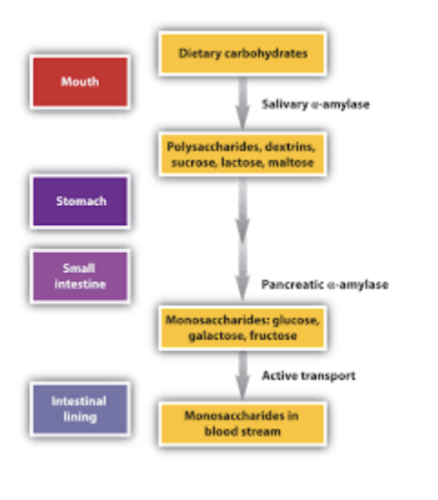
Glucose
a simple carbohydrate that circulates in the blood and is used to produce energy: also called blood sugar.
simple carbohydrates
contain one or two units of sugar per molecule and usually have a sweet taste.
energy dense NOT nutrient dense
refined sugars
sugars that undergo a process of refining and commonly found in many baked and packaged goods.
Glycemic Index
a scale that quantifies the effect of carbohydrate-containing food on the level of glucose in the blood
high GI = higher the glucose in the blood
What happnes when we have an excess of blood sugar?
Hyperglycemia - high blood sugar
fatigue
blurry vision
excessive thirst
increased urination
Recommended CHO intake
daily recommended intake for CHO - 130 grams
CHO should be about 45% -65% of our total daily calories
recommended that no more than 5-15%. of total daily calories comes from solid fats and added sugar
AMERICANS consume about 35% of their daily calories.
whats wrong with specific percentages or grams (amounts)?
>130g of carbohydrates per day for adults -
to vague
difficult to apply to yourself
We each need different amounts
what are guidelines for athletes
daily carbohydrate intake -
typically ranges between 5-12g/kg/day.
upper end of this range 8-12g/kg/day reserved for athletes training at moderate to high intensities upwards of 12 hours per week.
Fats
are category of essential macronutrient; an organic compound made up of fatty acids.
Energy Density
the amount of energy (calories) in food per unit of weight.
calorie (kcal)
a measure of energy in a food as well as a measure of the energy in a food as well as a measure of the energy burned through physical activity.
alcohol has 7 calories per gram
Amino acids
molecules that are the building blocks of proteins; there are 20 amino acids (nine essential amino acids cannot be made by the body).
What is anemia
below normal number of RBCs or lack of sufficient hemoglobin
This results in reduced carrying capacity of the blood
most often caused by insufficient iron, which is needed to produce hemoglobin.
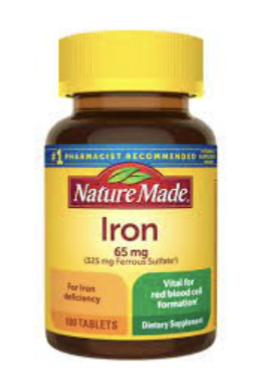
what are Antioxidants?
Antioxidant: A compound that protects cells from damage by free radicals by reacting with them or counteracting their effects
What are free radicals?
unstable, highly reactive molecules created during normal metabolism and in response to environmental factors; may aid development of cancer, cardio vascular disease, and other diseases of aging.
What is the recommended dietary intake?
A set of standards that includes recommended intakes of all essential nutrients, recommendation for balancing intakes of macronutrients, and upper safe limits for selected nutrients.
recomended dietary allowance RDA
A standard for dietary intake
of a nutrient set at a level to meet the needs of almost all (97-98%)
individuals in the population to maintain good health.

Tolerable Upper Intake Level (UL)
One of the standards that make up
The Dietary Reference Intakes: the highest level of daily intake of a
nutrient that poses no risk of adverse effects in healthy people.

National institute of health
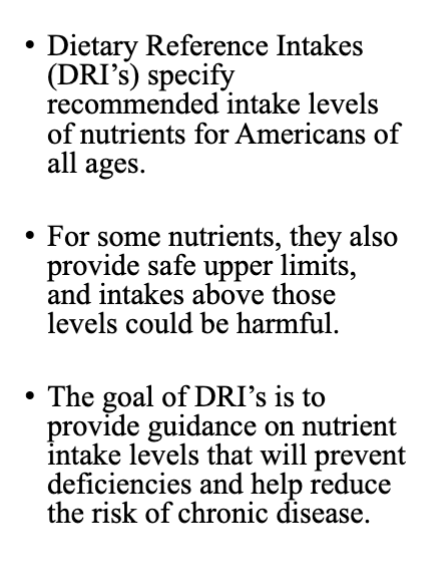
Energy Density
amount of energy in a food per unit of weight
Lots of calories - not any nutrients (crumble cookie)
need to limit this
Foods with high energy density have many calories, usually because they are high in fat and low in water and fiber.
Foods high in water and fiber have a low energy density, meaning they have a small number of calories by weight, so they can help fill
you up without providing a lot of calories

Nutrient dense
Food that is high in nutrients but relatively low in calories
The foods are nutrient-rich, meaning naturally abundant in vitamins, minerals, and other beneficial food compounds, but with relatively few calories.
Nutrient-rich foods are the opposite of energy-
dense foods.

Glycemic index (GI)
A measure of how quickly the CHO you consume increases that level of glucose in your blood
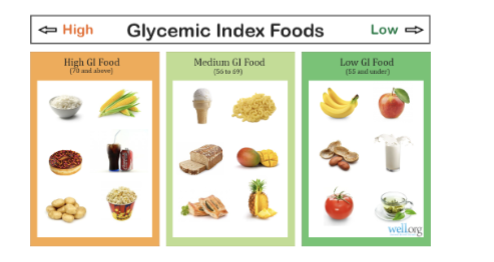
Glycemic load
a related measure, which considers the amount of CHO in a food or meal
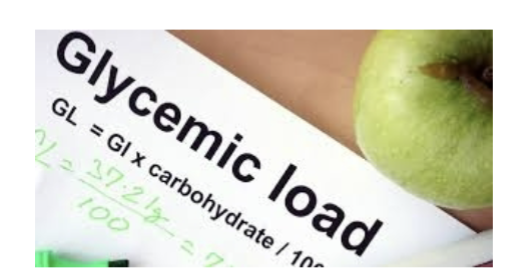
Fiber
a carbohydrate
Nondigestible CHO with serious health
benefits such as lowering rates of
cardiovascular disease, obesity, and type 2
diabetes.It also helps to lower blood pressure and
improve the regulation of blood glucose
levels.
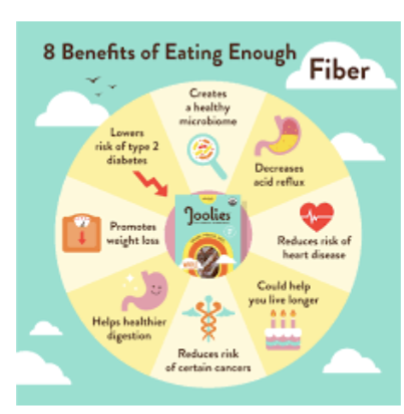
Soluable fibres
Soak up water and turns into a gel during digestion, slowing the
body’s absorption of glucose.Improves insulin sensitivity and may delay the return of hunger
after you eat. It also binds with cholesterol in the intestine for
quick removal.Some examples of soluble fiber foods are peas, soybeans, oats,
plums, bananas, broccoli, carrots, and sweet potatoes.
Insoluble Fibres
Binds water in the intestines, thereby making digested food bulkier and softer
and speeding the transit of food through the digestive system. Elimination is
easier and more complete.Some examples of foods that contain insoluble fiber are whole grains, wheat
bran, nuts and seeds, potatoes, the skin of apples and pears, flax, green beans,
and cauliflower.
Module 3 Part 2…
What are proteins
an essential macronutrient that is the major structural components of all your body cells
also functions as enzymes, hormones and carriers of important molecules throughout the body
4 calories per gram
How many essential and non essential amino acids?
11 amino acids (nonessential) can be made up by the body
9 amino acids (essential) cannot be made by the body
Complete vs incomplete proteins
complete proteins: contain all essential amino acids and are found in meat, fish, poultry, soybeans and soy products, eggs, and dairy products
Incomplete proteins: foods that lack one or more of the essential amino acids.
Ideally you want sources high in protein and low in saturated fats…
What is the recommended protein Intake
Healthy adults need at least 0.36 grams of protein per pound (0.8 grams per kilogram), regardless of sex
recommendations of 10-35% of total daily calories
Americans consume 15% of total calories as protein
What are fats?
Fats are needed in sufficient quantities for cellular integrity, healthy reproduction, absorption of fat-soluble, vitamins, support and cushioning of organs, and thermal insulation.
More info on fats?
Fats also provide energy - Consuming healthy fats
In limited amounts can benefit your health.However, choosing the wrong fats can increase your
risk of cardiovascular disease and type 2 diabetes.Fats in food are made up of different types of fatty
acids found in the form of triglycerides.Triglycerides contain three fatty acid molecules
Aerobic vs anaerobic fuel sources.
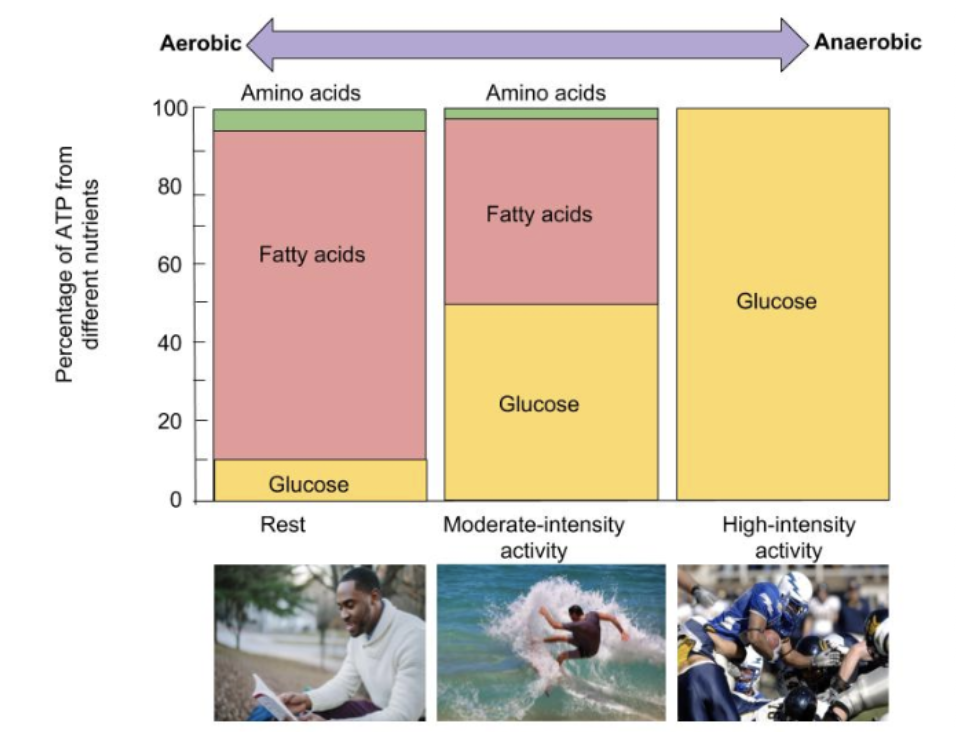
saturated vs unsaturated fats?
Saturated fats = have no double bonds
Unsaturated = have a double bonds (oils)
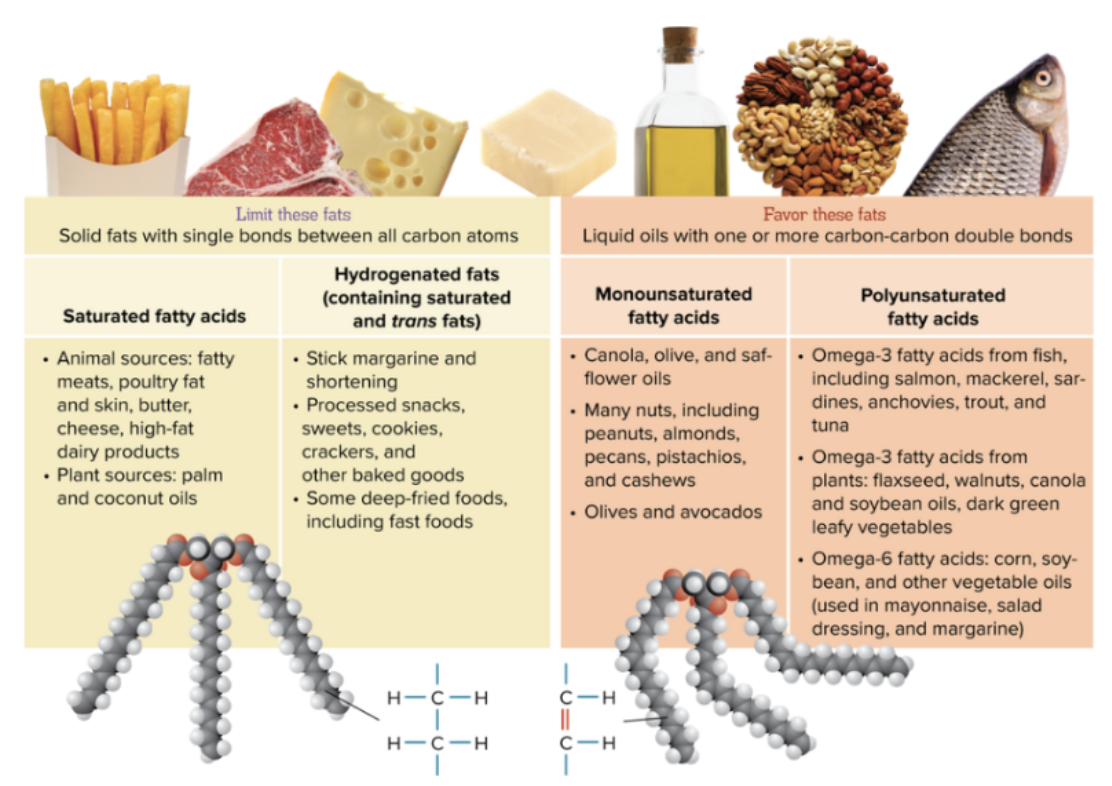
saturated fats?
When you consume saturated fats, they
acts on the liver to increase the number of
low-density lipoproteins (LDL) in your blood.Saturated fat is also associated with
insulin resistance in cells (negative)Can chronic disease result in this?
Type II diabetes
Your body can make all the saturated fats
You require, so saturated fatty acids from the diet, has no further health value.
What are saturated fats (two types of cholesterol)?
Bad = LDL
stores cholesterol in the blood stream
yellow (increases blood pressure)
Good (HDL)
regulates LDL storage an promotes excretion
green
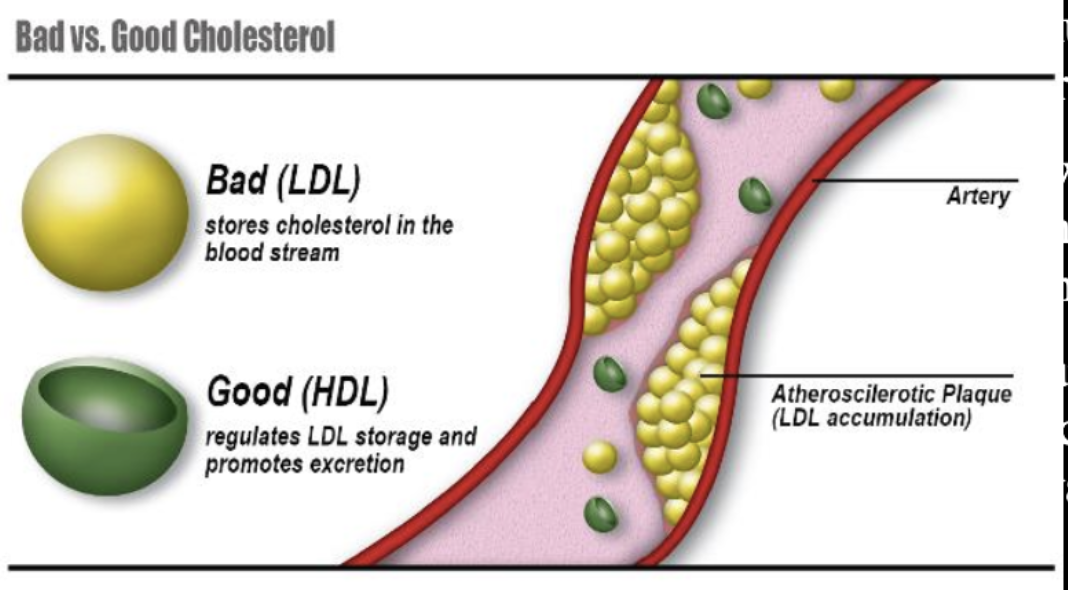
What are Trans fats?
Trans fats are produced during the process of hydrogenation - hydrogen atoms are added to unsaturated fatty acids, turning them into saturated fatty acids.
raises low-density lipoproteins.
Why do we have trans fats?
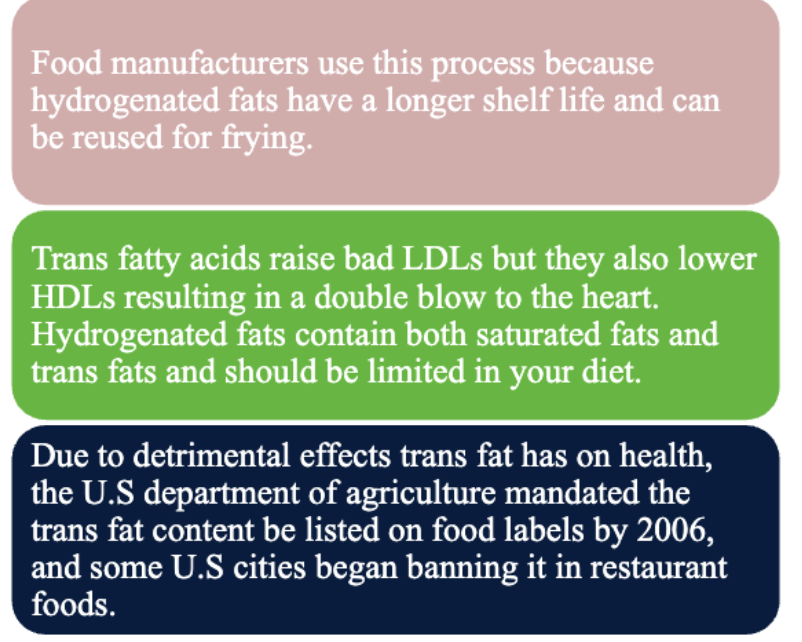
why is cholesterol good?
Cell membrane consistency, helps create steroid hormones (such
as Vitamin D).
why is cholestrol bad?
It can stick to blood vessels on artery walls (plaque formation), reducing blood flow but increasing blood pressure.
What is atherosclerosis?
Plaque narrows the space inside the artery.
What happens when the coronary arteries
become blocked?
• Potential heart attack.
What happens when the carotid arteries become
blocked?
Potential stroke
Is high-density lipoprotein good or bad
cholesterol?
• Good.
How can we decrease LDL and increase HDL?
• Heart-healthy diet (low saturated and trans fats).
• Physical activity and exercise.
• Reducing bad habits such as smoking.
What are the targets for fat and cholesterol intake
overall fat intake: 20%-35% of total daily calories
Saturated fat” 10% or less of total daily calories (initial goal), working toward 7% or less of total daily calories
Trans fat: avoid artificially produced trans fats: the small amount of trans fats in the diet should be from natural sources
dietary cholesterol: 300 mg or less per day for healthy adults, 200mg or less per day for people with or at risk for cardiovascular disease or type-2 diabetes
Module 3 Part 3…
What is water?
Digestion and absorption of food
main ingredient in the blood
provides lubrication, cushioning, and temperature control throughout the body
what are vitamins?
Vitamins are organic compounds, and minerals are inorganic compounds
Humans need 14 different vitamins and 17 different minerals
know what function of vitamin D, vitamin C, vitamin A, and vitamin B.
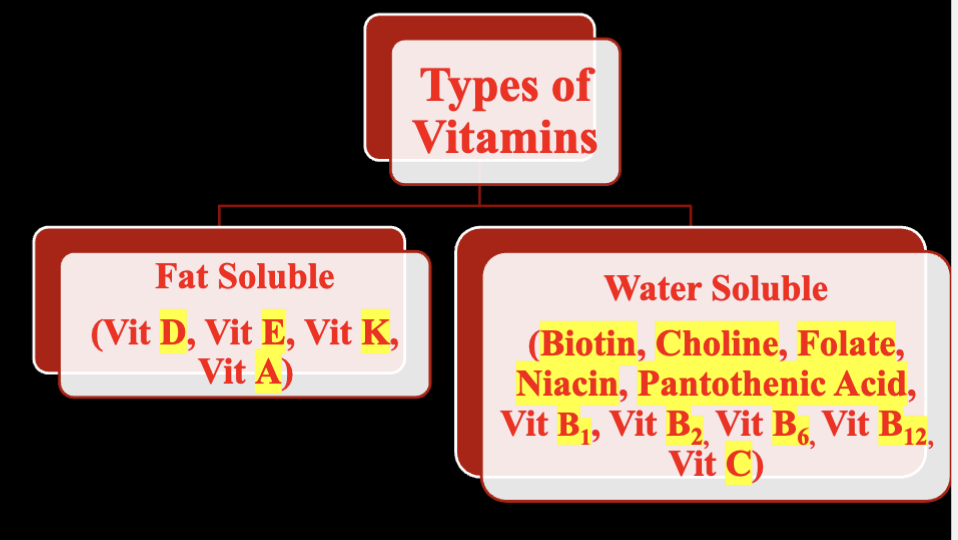
what are minerals
Also known as elements
Major minerals
Trace minerals
Functions of vitamins and minerals
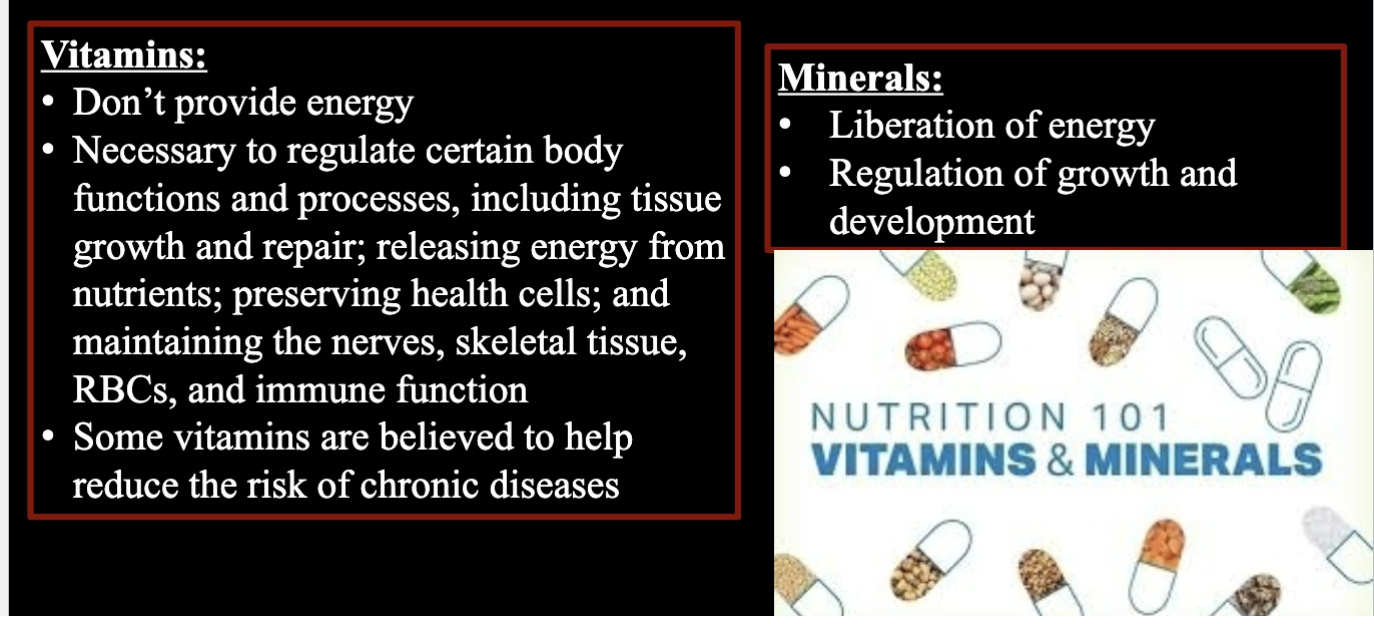
Module 4 Part 1…
what is stress?
The collection of physical and emotional changes we experience in response to the demands of stressors.
What are stressors?
physical or emotional demands from your external or internal enironment.
What is the the stress response: fight or flight?
under normal circumstances, your body is in a relatively relaxed and stable state of functioning.
when exposed to stressor perceived as a threat, the fight or flight response kicks in.
Sympathetic = fight or flight (autonomic)
epinephrine
Cortisol
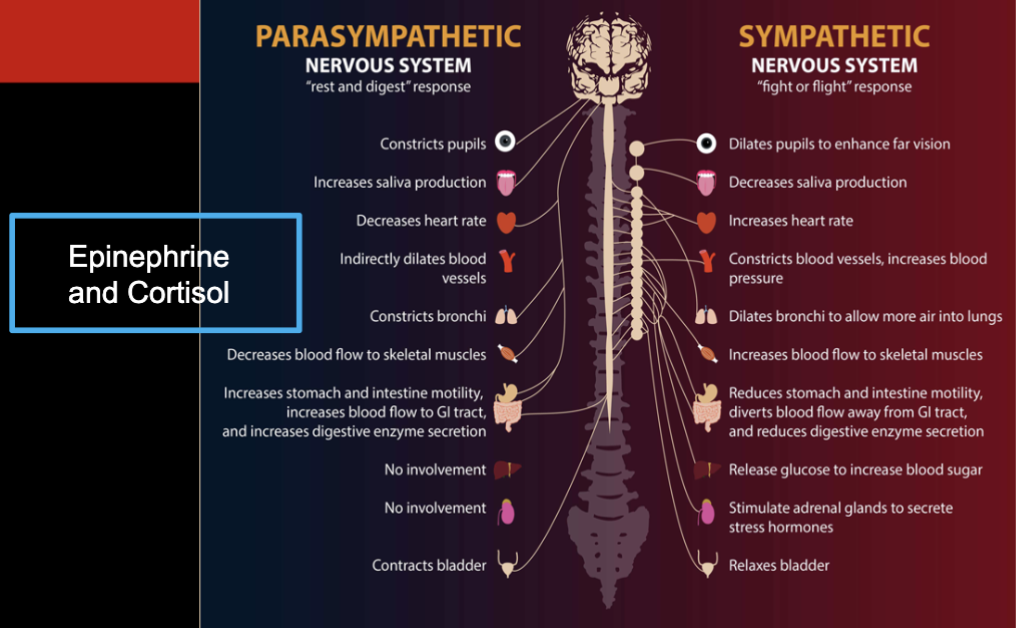
What does the sympathetic nervous system secret in response to stress?
epinephrine (adrenaline)
What physiological changes occur with the fight or flight response?
increased heart rate and BP
Increased breathing rate
increased blood flow to muscles, lungs, and the heart.
what brain region secretes stress hormones?
hypothalamus
what can cortisol do to the immune system?
suppress immune functions
What is fear and anxiety?
persistent state of worry, unease, and nervousness, not directed at any particular threat
What are the two types of fear/anxiety?
rational (useful)
Irrational (useless)
what is a phobia?
A persistent, unreasonable intense fear of a specific object, activity, or situation.
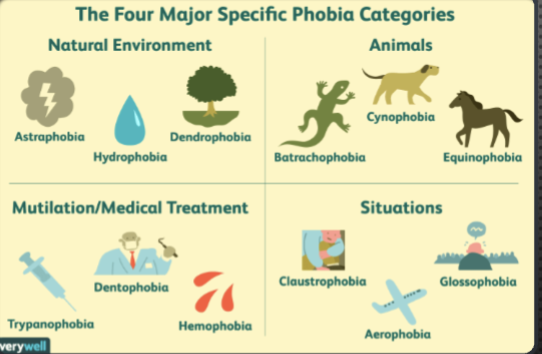
what is social phobia?
The fear of embarrassment or humiliation in social situations- may lead to avoidance of all social interaction creating social isolation.
What is Post Traumatic Stress Disorder (PTSD)?
Stress and/or fear without danger with concomitant nightmares and flashbacks.
What is Generalized Anxiety Disorder?
Fear or anxiety that is so constant that it interferes with your ability to function and relax
Constant high levels of anxiety can cause physical problems such as body aches, insomnia, and exhaustion.
How is personality determined?
your personality is the result of heredity as well as social, psychological, and behavioral factors
what is positive thinking?
a combination of things such as: believing in yourself, surrounding yourself with supportive people, and focusing on the good that can come from a situation.
Do men and women handle stress similarly?
MEN AND WOMEN HANDLE STRESS DIFFERENTLY
Men: confrontation/ fight or flight response
testosteronse
cortisol and adrenaline
Women: Tend to befriend
oxytocin
Gender and biological sex
gender and sex differences in response to stress have profound effect on wellness may be one of the reasons why women typically enjoy a longer life expectancy than men.
Things we stress about that we can’t control Is called
called a fear bubble
Module 4 Part 2…
Theories about Stress Responses?
Transactional model of stress: outlines how we all assess and approach a stressful situation.
ON the exam, what is not on the transactional model
Step 1: Primary appraisal - initial reaction to a stressor, when you determine whether the stressor presents harm (“Am I OK or am I in trouble?”). If you think you’re OK, then you are likely to move on. If you think you’re in trouble, you intuitively take the next step.
Step 2: Secondary appraisal - allows you to determine how much control you have over the threat (“what can I do now?”). If you feel a lot of control, then you will have minimal stress. Perceiving that you have no control means lots of stress and going to step 3.
Step 3: Coping – deciding what to do about the threat. You base this decision on
the situation and everything around you – people, material resources, thoughts,
emotions, cost versus benefit of different actions, and so on.Step 4: Reappraisal – Occurs after you have addressed the stressor. At this
point, you decide whether the threat still exists. If so, you begin the appraisal
process again; if not, you move on.
Theories About Stress Responses
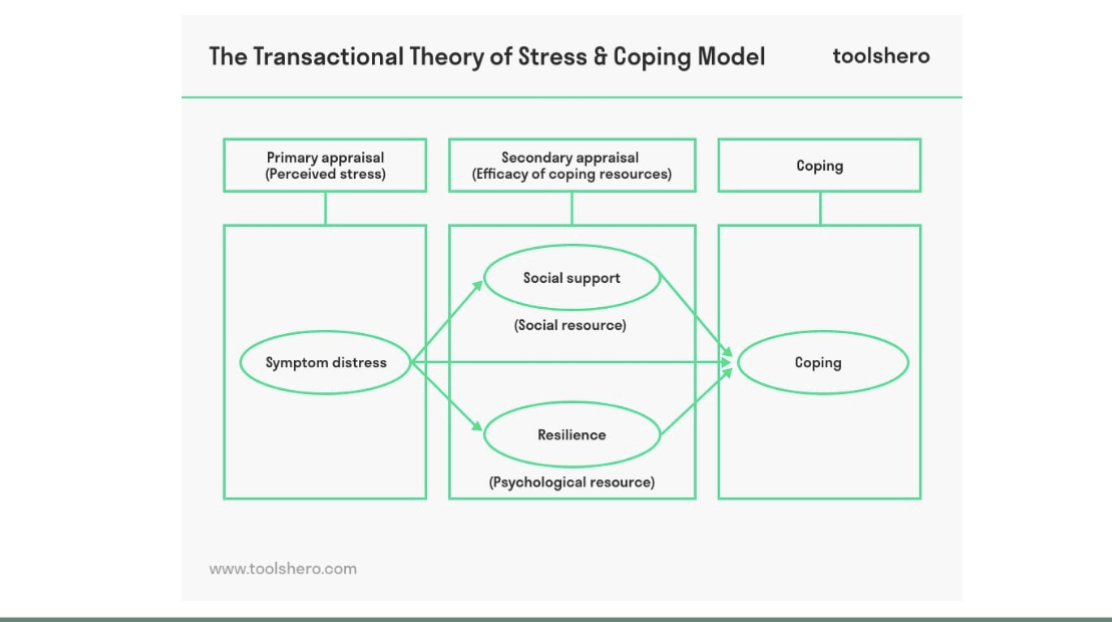
Coping with stress
Problem focus coping - involves attempting to do something practical constructive about the stressor.
Emotion focus coping - entails attempting to regulate emotions elicited by a stressful event - to feel less anxious and upset about the stressful circumstance
CAN INTERCHANGE BETWEEN THEM
Stress and Performance
often highlighted during sporting events
Yerkes Dodson curve - need moderate amount of stress.
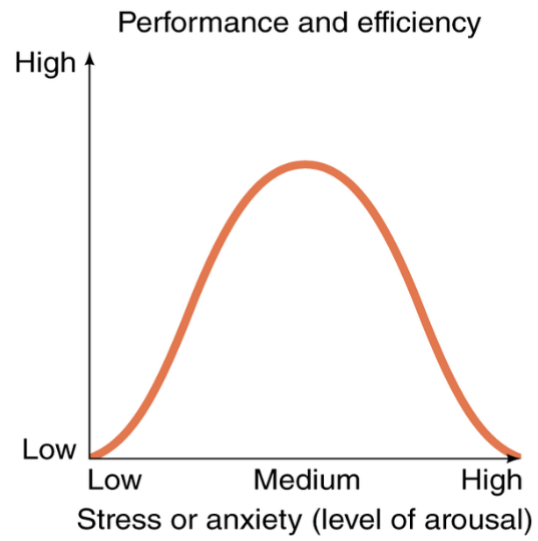
Acute vs Chronic Stress
Short term (Acute): results in the fight-or-flight responses and its associated changes. which includes a release of corticosteroids
Long term (Chronic): can be more serious or long-lasting, particularly as corticosteroid levels remain elevated
an early model of how chronic stress affects health in the general adaptation syndrome (GAS)
General Adaptation Syndrome
Stage 1: is the alarm reaction where there is an acute reaction to a stressor via the fight or flight response.
Stage 2 is the resistance stage where the body attempts to adapt to the
demands of a persistent stressor (such as a negative work environment, chronic physical pain).Stage 3 is the exhaustion stage where there is a state of impaired functioning that occurs if a persistent stressor exhausts the body’s resources for coping.
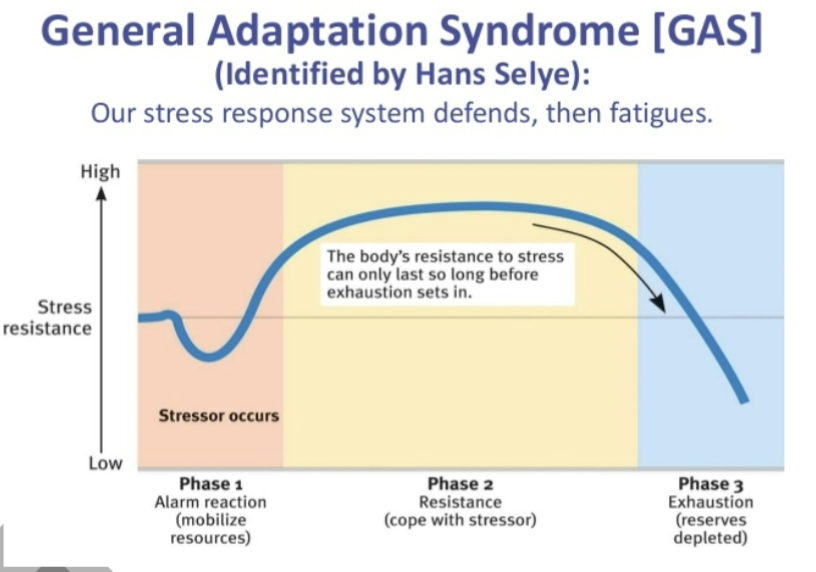
Sources of Stress?
life experiences and time pressures
Job and financial pressures
Relationships and families
Social and environmental stressors
Financial stressors or money is the BIGGEST stressors in the US.
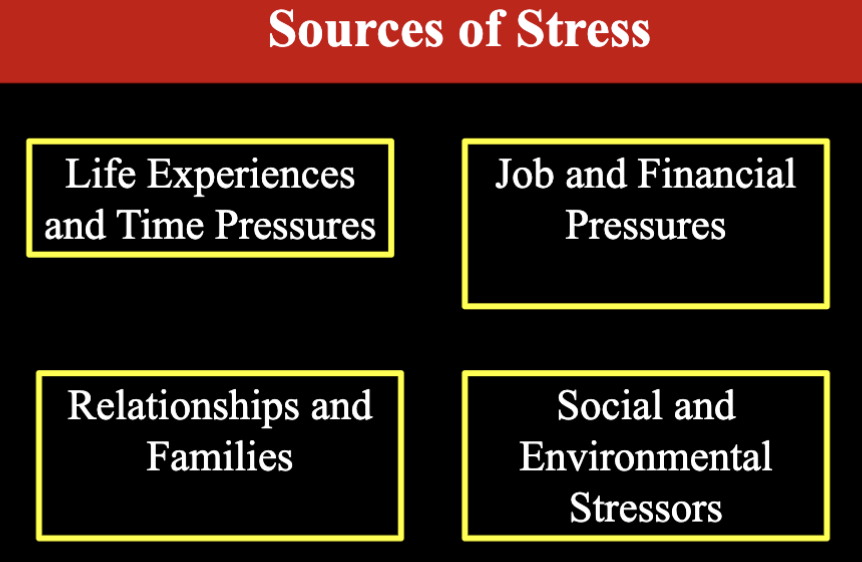
Social and Environmental Stressors
Social stressors: interacting with new people, facing tough competition or discrimination
Environmental stressors: crowded or loud residences, poor public transit, and extreme weather
Managing Stress
In surveys, more than 90% of Americans report trying some form of stress management technique.
Which one gets used the most: Eating healthier foods
Orange = used the least
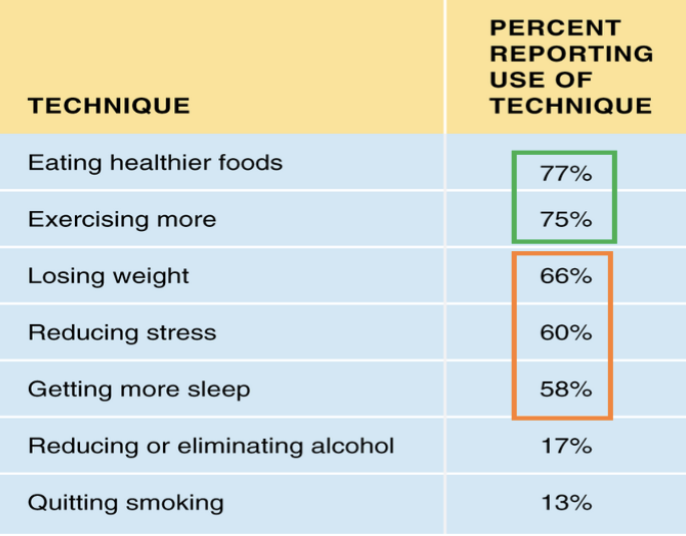
Don’t be inflexible
holding tightly to your patterns of thinking and behavior in the face of change may be comforting, but remaining stuck in familiar but unsuccessful paterns usually creates even more stress
Don’t avoid situations
Behavioral or cognitive avoidance will only ke the situation worse the next time
Time Management Tips
keep a time diary
Divide your time into small blocks
avoid distractions
don’t try to save time by skipping healthy habits.
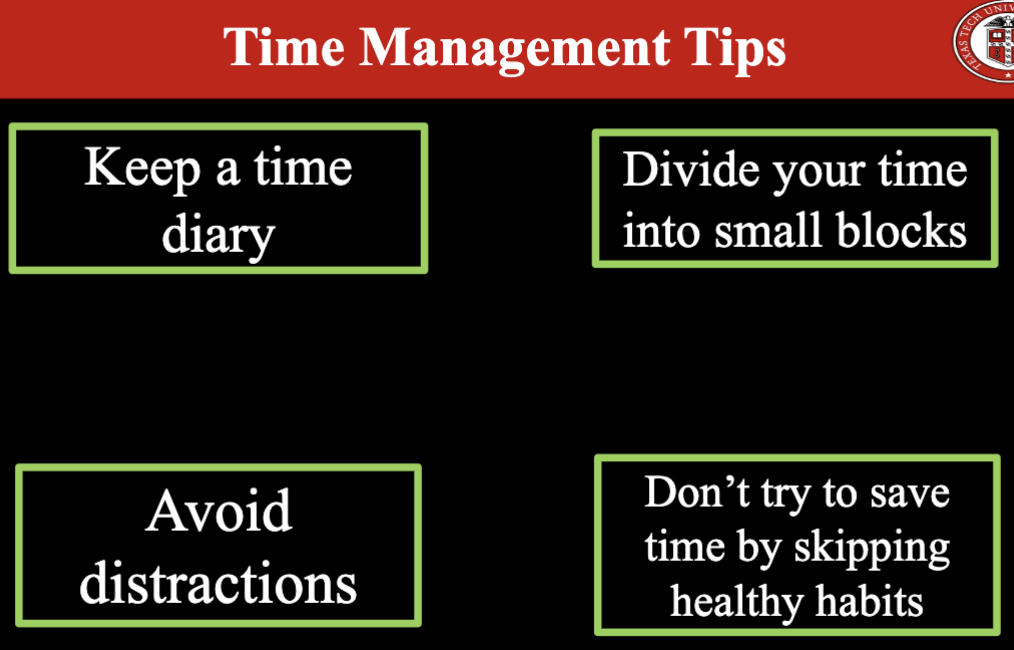
What are cognitive strategies?
Tools that can help us move on from stressors:
Engaging in realistic self-talk
focusing on the present
Setting realistic goals
Developing healthy problem solving techniques
Set Realistic Goals
Realistic goals are key for successful behavior change - and they are just as important for stress management.
Recognize your strengths and weakness and set realistic goals on them
Healthy Lifestyle Choices: Activity, Diet, and Sleep
Physical activity - even a brief exercise of as short as 10 minutes or less has been shown to elevate people’s moods, and the intensity doesn’t need to be too high.
Individuals who exercise tend to have a milder physical stress reaction to typical stressors.
strategies to ensure to healthy sleep
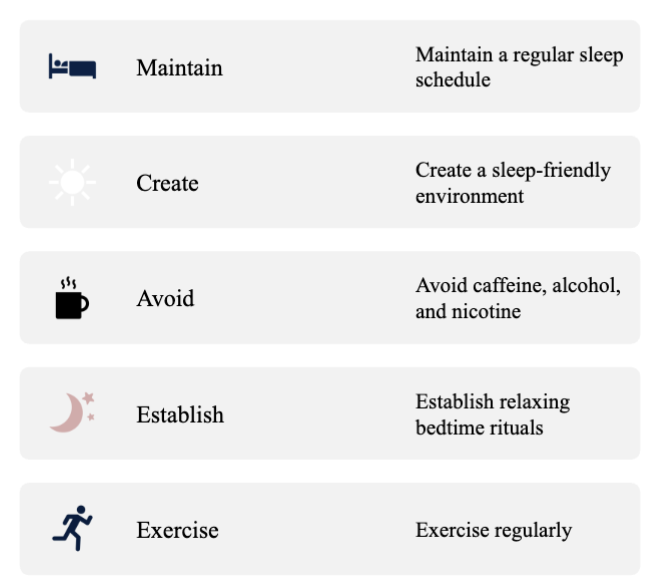
Exam overview.
60% on module 3 (nutrition)
40% on module 4
need to know carbohydrates (PRIMARY SOURCE OF ENERGY to glucose to blood -
NEED TO KNOW ALL OF THE STEPS
carbohydrates (bread/ pasta) mouth → salivary amylase → polysaccharide → stomach→ intestine ( pancreatic amylase) and then active transport into the intestinal lining to the bloodstream.
neede to know of GI vs glycemic load
GI - measure of how quickly CH you consume increases the level of glucose in your blood.
Glycemic Load - a related measure, which considers the amount of CHO in a food or meal.
Fiber = a type of carbohydrate that you can’t digest regardless if soluble or insoluble
lower bp
regulates blood glucose
recommended protein intake
healthy adults need to consume at least 0.36 grams of protein per pound of body weight (0.8 grams per kilograms) regardless of sex
NOT A fan of percentages (10-35%) of total daily calories
IN THE US INDIVIDUALS do eat adequate amounts of protein
short answer question?
probably going to be over digestion and the process